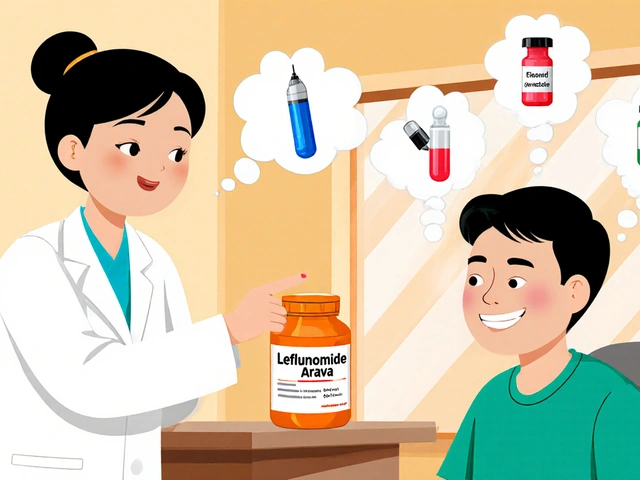Trying to decide whether Leflunomide is right for you or your patient? With dozens of disease‑modifying antirheumatic drugs (DMARDs) on the market, the choice can feel overwhelming. This guide breaks down Arava’s profile, measures it against the most common alternatives, and gives you a practical decision‑making framework.
What is Leflunomide and how does it work?
Leflunomide is an oral DMARD that blocks the enzyme dihydroorotate dehydrogenase, halting the production of pyrimidines needed for rapidly dividing immune cells. By slowing down T‑cell and B‑cell proliferation, it reduces the inflammatory cascade that drives joint damage in rheumatoid arthritis (RA).
Typical dosing starts with a 100 mg loading dose for three days, then settles at 10-20 mg once daily. The drug’s half‑life is unusually long-about two weeks-so steady‑state levels take several weeks to build, which also means side effects can linger after discontinuation.
Key criteria you should weigh when picking a DMARD
- Efficacy: How quickly does the drug reduce joint swelling and pain?
- Safety profile: What are the most common and most serious adverse events?
- Monitoring burden: How often do labs need to be checked?
- Convenience: Oral pill versus injection, dosing frequency.
- Cost and insurance coverage: Generic availability, co‑pay tiers.
- Patient‑specific factors: Pregnancy plans, liver health, kidney function, other meds.
Overview of the most frequently used alternatives
Methotrexate is the gold‑standard first‑line DMARD. It inhibits dihydrofolate reductase, limiting DNA synthesis in immune cells. Weekly oral or subcutaneous dosing makes it convenient, but it requires regular blood work for liver enzymes, blood counts, and renal function.
Hydroxychloroquine is an antimalarial repurposed for RA. It interferes with antigen presentation and Toll‑like receptor signaling. Dosed daily at 200-400 mg, it has a very mild safety profile but works best in mild disease or as part of a combination regimen.
Sulfasalazine is a sulfonamide derivative that modulates cytokine production. Given twice daily, it’s often paired with methotrexate or leflunomide for a “triple‑therapy” approach. Monitoring focuses on blood counts and liver enzymes.
Etanercept represents the biologic class of tumor‑necrosis‑factor (TNF) inhibitors. Administered as a weekly subcutaneous injection, it delivers rapid symptom relief but carries a higher infection risk and is pricier.
Upadacitinib is a selective Janus kinase (JAK) inhibitor taken once daily. It offers quick onset and works even when other DMARDs fail, but long‑term safety data are still evolving, especially regarding cardiovascular events.

Side‑by‑side comparison
| Drug | Mechanism | Route & Dose | Typical Onset | Monitoring | Common Side Effects | Cost Tier (US$) |
|---|---|---|---|---|---|---|
| Leflunomide (Arava) | Dihydroorotate dehydrogenase inhibitor | Oral, 10‑20 mg daily | 6‑12 weeks | Liver enzymes, CBC, pregnancy test | Diarrhea, hypertension, alopecia | $$ (generic) |
| Methotrexate | Dihydrofolate reductase inhibitor | Oral or subQ, 7.5‑25 mg weekly | 4‑8 weeks | Liver enzymes, CBC, renal function | Nausea, mucositis, pulmonary fibrosis (rare) | $ (generic) |
| Hydroxychloroquine | Inhibits TLR signaling | Oral, 200‑400 mg daily | 12‑24 weeks | Eye exam yearly | Retinal toxicity (rare), GI upset | $ (cheap) |
| Sulfasalazine | Modulates cytokines | Oral, 500‑1000 mg BID | 8‑12 weeks | Liver enzymes, CBC | Rash, GI upset, hemolysis (G6PD‑deficient) | $$ (generic) |
| Etanercept | TNF‑α blocker | SubQ, 50 mg weekly | 2‑4 weeks | Infection screen, TB test | Injection site reaction, infection | $$$$ (biologic) |
| Upadacitinib | JAK1 selective inhibitor | Oral, 15 mg daily | 1‑2 weeks | Lipid panel, CBC, infection watch | Herpes zoster, elevated lipids | $$$$ (specialty) |
Who is a good fit for Leflunomide?
If you need an oral DMARD that doesn’t require weekly dosing, Leflunomide shines. It’s especially useful when methotrexate is contraindicated-say, due to chronic liver disease, alcohol use, or intolerance to weekly injections. Patients planning pregnancy need a wash‑out period (cholestyramine) because the drug stays in the system for months, but for non‑reproductive‑age adults the convenience outweighs the monitoring hassle.
When alternatives may be preferable
- Methotrexate remains the first‑line choice for most newly diagnosed RA because its long track record shows high remission rates when combined with folic acid.
- Hydroxychloroquine works well in mild disease or as a steroid‑sparing add‑on; its safety profile is ideal for elderly patients with multiple comorbidities.
- Sulfasalazine is a solid option for those who can’t tolerate methotrexate and need a second‑line oral agent.
- Etanercept and other biologics are true game‑changers for aggressive disease, especially when early joint erosion is evident.
- Upadacitinib offers rapid control for patients who have failed two or more conventional DMARDs, but the cost and infection risk must be weighed.
Practical checklist before starting or switching
- Confirm diagnosis of rheumatoid arthritis (preferably ACR/EULAR criteria).
- Review liver function tests (ALT/AST), CBC, and renal panel.
- Discuss pregnancy intentions; ensure contraception if starting Leflunomide.
- Assess comorbidities: cardiovascular disease, infections, diabetes.
- Check insurance formularies-generic Leflunomide often costs less than biologics.
- Plan follow‑up labs: baseline, then at 2, 4, and 8 weeks after initiation.
- Educate the patient on signs of hepatotoxicity (jaundice, dark urine) and infection.
Managing common pitfalls
Liver toxicity is the most talked‑about issue with Leflunomide. If ALT rises above three times the upper limit, pause the drug and consider a cholestyramine wash‑out. Hypertension can creep up; monitor BP every month for the first three months. For patients who develop a rash or severe alopecia, switching to methotrexate or a biologic is advisable.
Bottom line - a quick decision guide
- Choose Leflunomide if you want a once‑daily oral pill, have contraindications to methotrexate, and can handle monthly labs.
- Pick methotrexate when you need the most evidence‑based first‑line option and can manage weekly dosing.
- Consider hydroxychloroquine or sulfasalazine for milder disease or as part of combination therapy.
- Reserve biologics or JAK inhibitors for high‑activity RA that hasn’t responded to conventional DMARDs.
How long does it take for Leflunomide to start working?
Most patients notice a reduction in joint pain and swelling after 6-12 weeks, although full disease control may take up to six months.
Is it safe to use Leflunomide with methotrexate?
Combining the two can increase efficacy but also raises the risk of liver toxicity. If a clinician chooses this combo, liver enzymes must be checked every 2 weeks initially.
Can I become pregnant while on Leflunomide?
No. Leflunomide is teratogenic. Women of child‑bearing potential must use effective contraception and undergo a cholestyramine wash‑out before trying to conceive.
What are the biggest differences between Leflunomide and Etanercept?
Leflunomide is an oral small‑molecule DMARD with a slower onset and a need for liver monitoring. Etanercept is a biologic injection that works fast but carries higher infection risk and a much higher price tag.
Do I need to take folic acid with Leflunomide?
Folic acid isn’t required for Leflunomide, unlike methotrexate, but a standard multivitamin can be helpful for overall health.


jessie cole
Dear reader, you have before you a comprehensive guide that demystifies the complex world of DMARDs. It is presented with clarity, compassion, and an unwavering commitment to patient‑centered care. By weighing efficacy, safety, and convenience, you can make an informed choice that aligns with your lifestyle. Remember, the journey to remission is a collaborative effort between you and your healthcare provider. Stay hopeful, stay vigilant, and may your joints find lasting relief.
barnabas jacob
In the pantheon of DMARDs, Leflunomide occupies a questionable niche, riddled with pharmacokinetic quirks that many clinicians overlook. One must question whether prescribing a drug with a two‑week half‑life and a protracted wash‑out is truly ethical, especially when cheaper, well‑studied options exist. The literature is replete with data, yet some prescribers defiantly ignore the hepatic red flags. It is high time we hold ourselves accountable and not just chase the newest oral pill for convenience's sake.
Deja Scott
It is noteworthy how therapeutic choices often reflect regional prescribing cultures; in some locales, oral agents like Leflunomide are preferred to avoid injection stigma. This guide respects those cultural nuances while still emphasizing evidence‑based decision making. By acknowledging patient preferences alongside clinical data, we can foster a more inclusive treatment paradigm.
Rajesh Myadam
Absolutely, understanding the cultural context can make a huge difference in adherence. Your point highlights why shared decision‑making is essential, ensuring patients feel heard and respected throughout their treatment journey.
Mahesh Upadhyay
Leflunomide's slow onset is a glaring flaw; patients waiting months for relief are essentially being penalized for tolerating a cumbersome monitoring regimen.
Wesley Humble
While the delayed therapeutic window may appear suboptimal, numerous randomized controlled trials have demonstrated comparable ACR20 response rates to methotrexate after the 12‑week mark. 📊 Moreover, the oral administration eliminates injection‑related adverse events, which is a non‑trivial consideration for many patients. It is essential to weigh both pharmacodynamic timelines and real‑world adherence factors before dismissing Leflunomide outright.
Natalie Morgan
Consider the big picture – a once‑daily pill can fit seamlessly into a busy routine and free you from weekly injections that interrupt daily life
Sebastian Green
That convenience can indeed boost long‑term adherence.
Kirsten Youtsey
The so‑called 'in‑depth comparison' suffers from a veneer of objectivity that belies its underlying patronage of entrenched pharmaceutical interests.
One senses an implicit bias toward agents that conveniently align with the pricing strategies of major biotech conglomerates.
The metrics selected for efficacy, while ostensibly comprehensive, neglect the nuanced patient‑reported outcomes that truly dictate quality of life.
Furthermore, the safety profile discussion is perfunctory, glossing over rare but decisive adverse events that have been documented in post‑marketing surveillance.
It is also remiss not to mention the selective citation of studies, favoring those that support oral DMARDs while marginalizing data on biologics.
The cost analysis, presented in simplistic tier symbols, fails to account for the labyrinthine rebate structures that obscure true financial burden.
A discerning clinician would also interrogate the omission of pharmacogenomic considerations, which are increasingly relevant in personalized rheumatology.
The recommendation to opt for Leflunomide in the presence of liver disease is, at best, a cavalier oversimplification.
Contrary to the article's insinuation, methotrexate possesses a robust safety net when coupled with folic acid supplementation.
The commentary's emphasis on convenience overlooks the psychological ergonomics of patient autonomy, a factor not easily quantified.
Moreover, the brief mention of JAK inhibitors sidesteps the impending regulatory scrutiny surrounding cardiovascular risk.
One cannot ignore the strategic timing of this publication, coinciding with upcoming patent expirations of several blockbuster biologics.
Such synchronicity suggests an orchestrated effort to steer prescribers toward cost‑effective yet less innovative therapies.
In the grand scheme, the article serves as a subtle instrument of market manipulation, cloaked in the garb of clinical guidance.
Therefore, the astute reader should approach this guide with a healthy dose of skepticism and seek supplemental sources.
Only through rigorous independent appraisal can one truly navigate the complex therapeutic landscape of rheumatoid arthritis without succumbing to hidden agendas.
Matthew Hall
Wow, look at the hidden agenda vibes-like they’re trying to pull the rug from under patients with fancy jargon. It's almost as if the pharma giants are whispering backstage, directing us to cheaper pills while they cash in on the side. This whole piece feels like a script written by the very people who profit from the meds they “recommend.” If you ask me, the truth is being buried beneath layers of “clinical” fluff.
Vijaypal Yadav
In addition to the points already raised, it is worth noting that the recent network meta‑analysis published in *Arthritis & Rheumatology* (2024) ranks Leflunomide lower than both methotrexate and upadacitinib in terms of ACR50 response at 24 weeks, providing a more granular perspective on its relative efficacy.